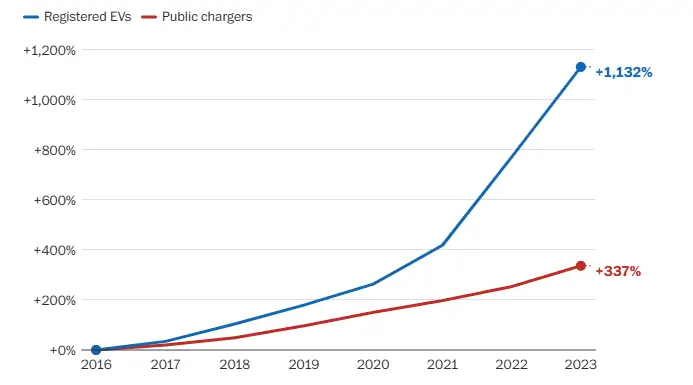Electric vehicles (EVs) are popping up everywhere, from Tesla Model 3s to Hyundai Ioniq 5s. In 2023, nearly 1.2 million EVs were sold in the U.S., setting a new record. But there’s a problem – the charging infrastructure isn’t growing as fast.
With over 20 EVs for each public charging station, this imbalance threatens the progress of the electric car movement. What’s causing this issue, and how can it be fixed?
Why Public Charging Stations Can’t Keep Up with EV Sales (PDF)
The EV Boom and Charging Crisis:
The rise in electric vehicle sales has been remarkable. In 2023, EVs accounted for over 7% of new car sales in the U.S. This growth shows a shift towards greener transportation. However, as more EVs hit the roads, the need for public charging stations becomes more urgent. Data shows that from 2016 to 2023, EV registrations grew almost three times faster than public charging infrastructure. Back in 2016, there were seven EVs for each public charger. Now, there are over 20.

Why the Slow Build-Out?
Several reasons contribute to the slow pace of building new public charging stations. First, the investment needed to create and maintain these stations is significant. Even with the U.S. government pledging $7.5 billion to expand fast-charging networks, progress has been slow. By March 2024, only seven new stations and 38 individual chargers had been added.
Second, there’s the problem of standardization. EVs in the U.S. use different connectors, which creates compatibility issues. Tesla’s Supercharger network, while extensive, needs adapters for non-Tesla vehicles, making the charging process more complicated.
Home Charging: A Partial Solution
Interestingly, about 80% of EV charging happens at home, according to the U.S. Department of Energy. This eases some of the pressure on public charging networks. However, this solution isn’t available to everyone. About one-third of Americans don’t have access to a garage or carport, making public charging stations essential for these drivers.
The Global Perspective:
Globally, the ratio of public chargers to EVs varies. The International Energy Agency reports about one public charger for every 11 EVs. In China, where many drivers live in multifamily housing, there’s roughly one charger per eight EVs. Norway, a leader in EV adoption, has a much higher ratio, with one charger for every 34 EVs. This variation highlights the importance of tailoring charging infrastructure to local needs.
Experts Weigh In:
According to Peter Slowik of the International Council on Clean Transportation, there isn’t a perfect ratio of EVs to public chargers that fits every scenario. “It all depends on the local context,” he says. Studies suggest that in the U.S., a target of one public charger for every 10 to 15 EVs could drastically cut down wait times, making it much easier for drivers to find an available charger. This more customized approach can help meet the diverse needs of different areas, ultimately making EV ownership more attractive and practical.
Potential Solutions:
- Increased Investment: More funding from both the public and private sectors is crucial. This includes expanding grants, subsidies, and incentives for companies to build charging stations.
- Standardization of Connectors: Encouraging automakers to adopt a universal charging standard could simplify the charging process and make stations more versatile.
- Public-Private Partnerships: Collaborations between governments, utility companies, and private firms can speed up the deployment of charging infrastructure.
- Innovation in Charging Technology: Advances in fast-charging technology could reduce the time vehicles spend at charging stations, effectively increasing the capacity of existing infrastructure.
Looking Ahead
The EV market is set to keep growing, underscoring the need for a robust charging infrastructure. Some experts, like Peter Slowik, are optimistic, suggesting that the U.S. is on the right path to meeting future charging demands.
However, others caution that if significant improvements aren’t made soon, drivers may face long waits and growing frustration.
Wrapping Up:
The shift to electric vehicles is rapidly gaining traction, but for this transition to succeed, charging infrastructure needs to catch up. With more Americans opting for EVs, it’s crucial to ensure that public charging stations are plentiful and reliable. The big question is, can the U.S. tackle this challenge and fully embrace the green transportation revolution?
What do you think? Are we on the right path to fixing the EV charging issue?



